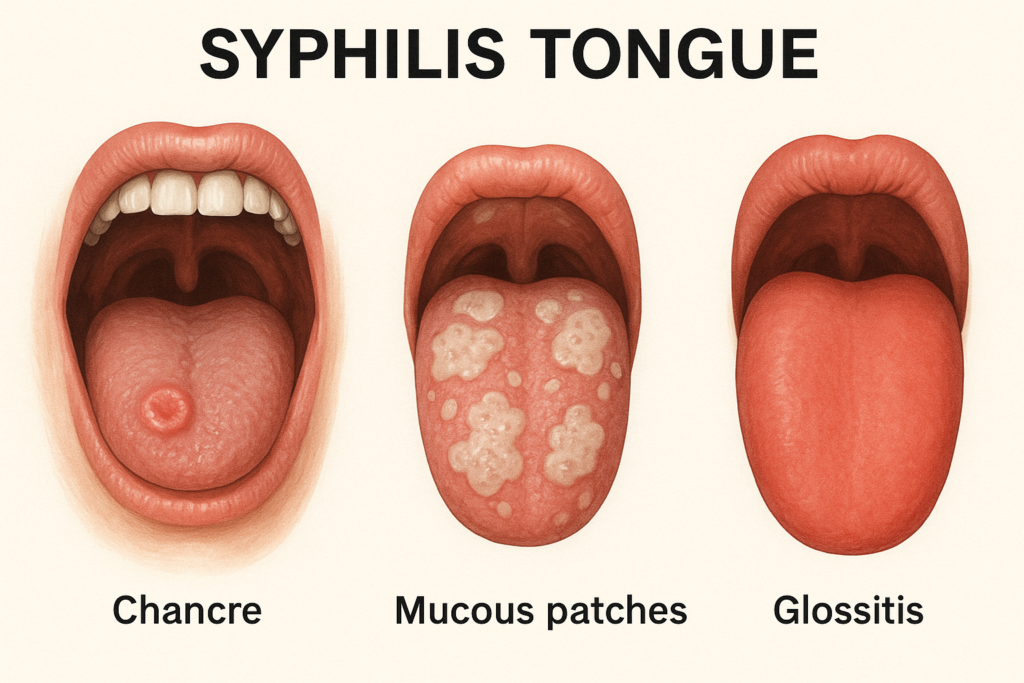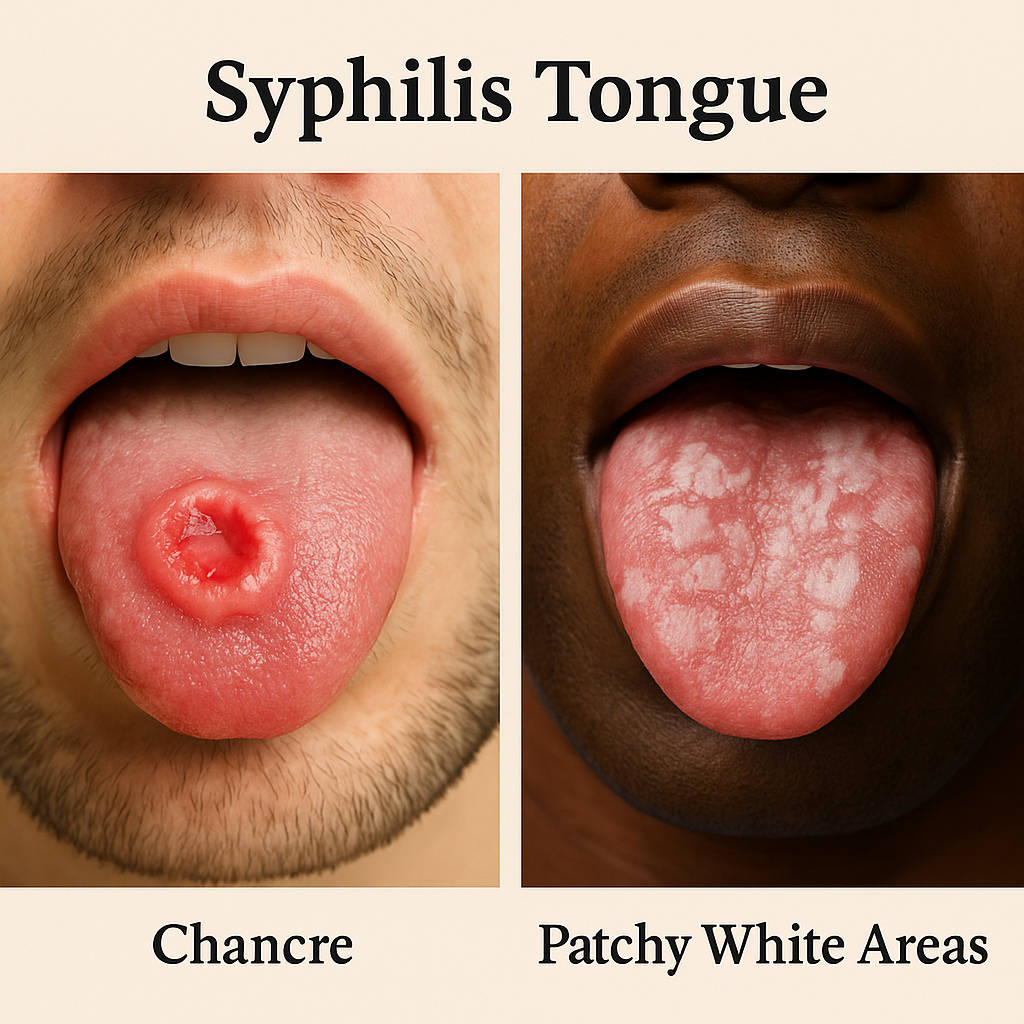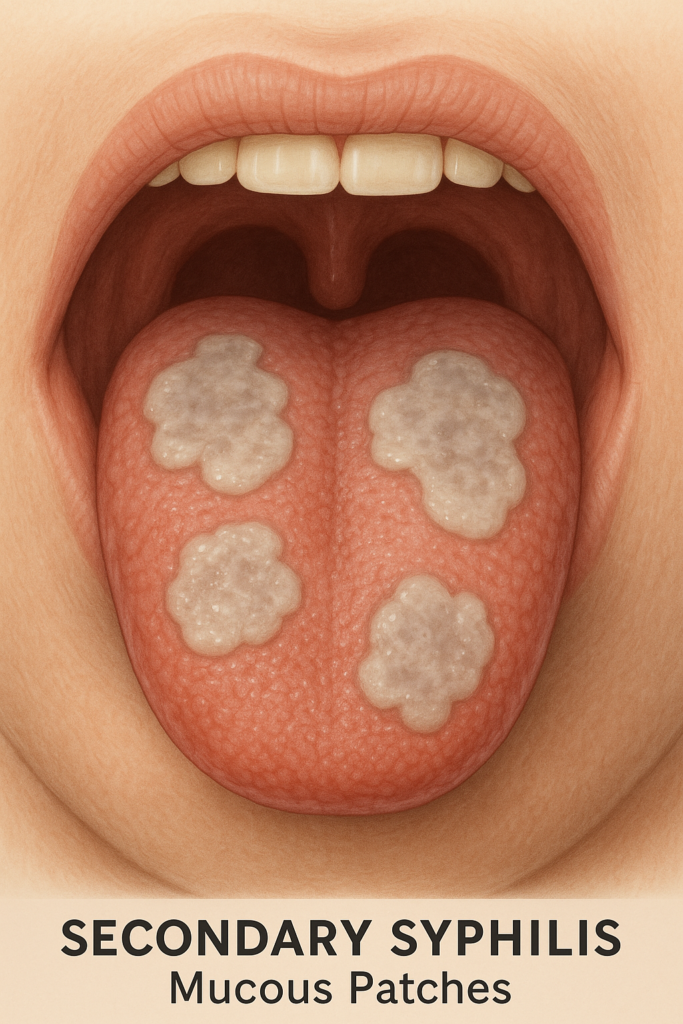Syphilis is a sexually transmitted infection (STI) caused by a bacterium called Treponema pallidum. While syphilis is often associated with genital symptoms, many people do not realize that it can also affect the mouth and tongue. Oral syphilis is becoming increasingly common in the United States due to the rise of oral sexual practices and low awareness about STI transmission through the mouth.
One of the key signs of oral syphilis is what many people refer to as “syphilis tongue” — changes in the tongue’s appearance and texture that may include sores, ulcers, white patches, or red smooth areas. Because these symptoms can look similar to other conditions, recognizing early signs is essential for timely diagnosis and treatment.
How Syphilis is Spread to the Mouth
Syphilis spreads through direct contact with a syphilis sore (called a chancre). These sores can appear on:
- The genitals
- The anus
- The lips
- Inside the mouth or on the tongue
Transmission can occur through:
- Oral sex
- Kissing (if there is an active sore)
- Sharing items in contact with open sores (rare but possible)
This means syphilis can infect someone even if there was no penetrative sex. Many U.S. adults are unaware of this, contributing to delayed diagnosis.
Early Symptoms of Syphilis on the Tongue
Oral symptoms most commonly appear during the primary and secondary stages of syphilis. Early recognition is crucial because treatment works best in the early phase.
1. Primary Stage: Painless Sores (Chancres)
- A single, round, painless sore may appear on the:
- Tongue surface
- Lips
- Gums
- Inside cheeks
What it looks like (Picture Description):
A smooth, round ulcer with raised edges and a reddish or raw-looking center. It does not hurt, which makes people ignore it.
Many mistake this for:
- A “bite injury”
- A canker sore
- A healing burn from hot food
However, canker sores hurt — syphilis sores usually do not.
2. Secondary Stage: Rashes and Tongue Patches
If untreated, syphilis progresses to the secondary stage, which can affect multiple parts of the mouth.
Common tongue signs include:
| Symptom | Description | What It Looks Like |
| Mucous Patches | Small, soft, moist lesions | White or grayish patches that may merge |
| Glossitis | Inflammation of the tongue | Smooth, shiny tongue surface |
| “Map Tongue” Lesions | Red and white irregular patches | Patchy appearance, like a map |
| Sore Throat | Without cough or cold symptoms | Constant throat irritation |
Picture Description:
Patchy white or gray smooth areas on the tongue or inside cheeks, sometimes surrounded by redness. They may look similar to oral thrush but do not scrape off easily.
Other Symptoms That May Accompany Syphilis Tongue
Because syphilis affects the whole body, patients may also experience:
- Skin rashes on palms and soles
- Hair loss in patches
- Swollen lymph nodes
- Fever
- Fatigue
- Muscle aches
These symptoms often lead to misdiagnosis as flu or allergies.
How Syphilis Tongue Differs From Other Oral Conditions
Many oral conditions resemble syphilis signs. Here’s how to tell the difference:
| Condition | Key Difference |
| Canker sores | Painful; syphilis sores are usually painless |
| Oral thrush (yeast) | White coating scrapes off; syphilis patches do not scrape off |
| Leukoplakia | Related to smoking; patches usually firm |
| Oral herpes | Painful fluid-filled blisters that burst |
| Geographic tongue | Benign condition; no systemic symptoms |
Because symptoms are similar, only a medical test can confirm syphilis.
Diagnosis: How Doctors Test for Syphilis
If oral syphilis is suspected, a doctor may:
- Perform a blood test
- VDRL, RPR, TPHA, or FTA-ABS tests
- Examine oral sores
- Sometimes using biopsy or swab
Testing is quick, confidential, and widely available in the U.S. at:
- Planned Parenthood
- Local health departments
- Urgent care clinics
- Primary care offices
Treatment: Syphilis Is Curable
The primary treatment for syphilis is:
Penicillin G injection
- Usually one injection for early-stage syphilis
- More doses for later stages
Important:
Do not try home remedies.
Do not self-treat with antibiotics.
Stopping treatment early can lead to serious complications.
Once treated:
- Sores heal
- Symptoms disappear
- The infection does not return unless re-exposed
When to See a Doctor
Seek medical help if you notice:
- A painless sore on the tongue or lips
- White or gray patches in your mouth that do not scrape off
- A smooth, shiny, or “map-like” tongue surface
- Swollen neck lymph nodes
- A new oral sore after unprotected sex or oral sex
Do not wait — early treatment prevents long-term harm.
If you are sexually active, especially with multiple partners, consider regular STI screening every 3 to 6 months.
Can Syphilis Tongue Be Prevented?
Yes — reduce risk by:
- Using condoms and dental dams during oral sex
- Avoiding sexual contact with anyone who has visible sores
- Getting tested regularly
- Ensuring partners are also tested
Bottom Line
Syphilis tongue is an important sign of an infection that is entirely curable, especially when detected early. Because oral symptoms can be painless or easily mistaken for minor issues, awareness is crucial. If you notice unexplained mouth sores or tongue changes — especially after new sexual contact — do not ignore them. Early testing and treatment protect both your health and the health of your partners.
If you have symptoms, schedule an STI test with a healthcare provider as soon as possible.



